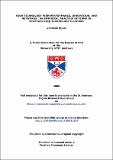High technology firm performance, innovation, and networks : an empirical analysis of firms in Scottish high technology clusters
Abstract
This thesis is an empirical analysis of the performance, innovation and networks of high
technology firms. It is conducted at the micro-economic level, based on new empirical
evidence by fieldwork methods, from the primary source data on firms in the five Scottish
hi-tech clusters. The questionnaire design is cross-sectional, to which was added a time
series element, and involves many unique features. It enabled the gathering of rich
quantitative and qualitative data on all stages of the dynamic innovation process. The
database was used in cross-sectional analysis of many key hypotheses in the hi-tech
context, by robust econometric models of export, innovation (e.g. Schumpeterian
hypothesis), and growth (e.g. Gibrat’s Law of Proportionate Effect) performances. The hi-
tech firm’s networks, internationalisation and embeddeddness, are analysed using novel
measures.
A structural simultaneous equations model is developed to explain the relationship between
networks, innovation and performance, by establishing a link between the innovation input,
the innovation output, and performance, based on the empirical knowledge production
function model. The 2-stage, 4 equations model, (using Heckman’s procedure) deals with
both simultaneity and sample selection bias. Robust estimation techniques (I3SLS, Tobit)
are used for estimation.
The results highlight the simultaneity and selectivity issue. The hi-tech firms with
aggressive innovation strategies, international markets and global products, still find it vital
to be embedded in local networks, which in turn raise their performance. Technology-push
factors, research networks, knowledge spillovers from markets, and a firm’s radical
innovation attempts determine its innovation input intensity. Firms are unable to attain
innovation success through innovation investments alone; integration of internal and
external resources is important. The innovation sales intensity are not determined by
innovation input, but by the demand-pull factors like customer networks, exporting, and
market expansion strategies. This also applies to their export intensity. Lack of internal
resources, capabilities, and government support are the major obstacles to
commercialisation of innovation.
Type
Thesis, PhD Doctor of Philosophy
Rights
Creative Commons Attribution-NonCommercial-NoDerivs 3.0 Unported
http://creativecommons.org/licenses/by-nc-nd/3.0/
Collections
Except where otherwise noted within the work, this item's licence for re-use is described as Creative Commons Attribution-NonCommercial-NoDerivs 3.0 Unported
Items in the St Andrews Research Repository are protected by copyright, with all rights reserved, unless otherwise indicated.


